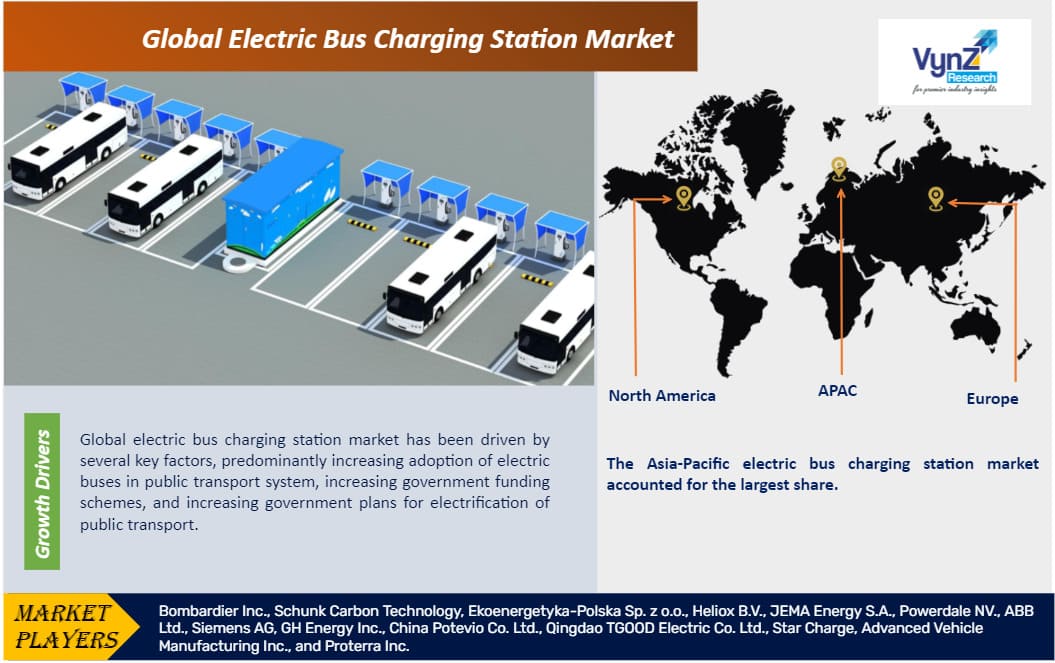| Status : Published | Published On : Dec, 2023 | Report Code : VRAT4061 | Industry : Automotive & Transportation | Available Format :

|
Page : 171 |

Global Electric Bus Charging Station Market – Analysis and Forecast (2025-2030)
Industry Insights by Charger (Off-Board, On-Board), by Type (Depot Charging, Opportunity Charging, Inductive Charging), by Power (<50 kW, 50–150 kW, 150–450 kW, >450 kW)
Industry Overview
The global electric bus charging station market is projected to reach USD 13.4 billion by 2030, registering a CAGR of 10.5% during the forecast period. Increasing adoption of electric buses in the public transportation system, supporting government initiatives and schemes, and growing investment towards charging station infrastructure, propelling the growth of the market.

Electric Bus Charging Station Market Segmentation
Insight by Charger
On the basis of charger, the global electric bus charging station market is categorized into off-board and on-board chargers, wherein on-board category accounted for larger share in 2020 in terms of sales volume. The category is expected to lead throughout the forecast period. However, the off-board category is expected to witness faster growth during the forecast period because it offers the electric bus manufacturers to reduce the weight of the buses and makes it lighter, with the help of off-board station. This will result in fast charging at higher power levels.
Insight by Type
On the basis of type, the global electric bus charging station market is divided into depot charging, opportunity charging, and inductive charging. Of all, the depot charging category accounted for largest share in 2020 in terms of sales volume. This is attributed to the increasing demand of private and public transport agencies towards overnight charging buses, depot charging stations have more similar operational characteristics to diesel buses.
Insight by Power
On the basis of power, the global electric bus charging station market is categorized into less than 50 kW, 50–150 kW, 151–450 kW, and more than 450 kW. Of all, the less than 50 kW category accounted for largest share in 2020 in terms of volume. The major reason behind the growth of the category in the market is the lower cost associated with these charging stations.
Global Electric Bus Charging Station Market Report Coverage
|
Report Metric |
Details |
|
Historical Period |
2018 - 2023 |
|
Base Year Considered |
2024 |
|
Forecast Period |
2025 - 2030 |
|
Market Size in 2024 |
U.S.D. Billion |
|
Revenue Forecast in 2030 |
U.S.D. Billion |
|
Growth Rate |
% |
|
Segments Covered in the Report |
|
|
Report Scope |
Market Trends, Drivers, and Restraints; Revenue Estimation and Forecast; Segmentation Analysis; Impact of COVID-19; Companies’ Strategic Developments; Market Share Analysis of Key Players; Company Profiling |
|
Regions Covered in the Report |
|
Industry Dynamics
Electric Bus Charging Station Market Growth Drivers
Global electric bus charging station market has been driven by several key factors, predominantly increasing adoption of electric buses in public transport system, increasing government funding schemes, and increasing government plans for electrification of public transport.
Different governments across the globe are taking initiatives to replace the petroleum-based automotive fleet with electric powered vehicles. Different countries provide incentive and frame regulations to support the adoption of electric vehicles. In European Union, governments are undertaking key initiatives to opt for green energy-driven vehicles. The policies related to electric buss in EU is mainly focused on technological optimization and market development.
Similarly, China has an aggressive target to reduce carbon emission and adopt electric vehicles. As reported by Forbes, the central and local government in China spent $ 7.7 billion on electric vehicles subsidiary in 2017. Similarly, in China electric vehicles are exempt from purchase taxes during 2014 – 2017, Chinese government has further extended it to 2020. The Chinese government at Centre offers consumers subsidy renews its plans in every two or three years. For battery electric vehicles, subsidies were around 40 to 60% of the vehicle cost. Also, in 2018, the country implemented dual-credit policy which targets automakers selling passenger vehicles based on their average fuel consumption credits and new energy vehicle credits. This applies to the manufacturers of 30,000 vehicles or more annually. All the above stated factors help in the growth of the electric bus charging station market.
Electric Bus Charging Station Market Challenges
Key factors hindering the growth of the global electric bus charging station market are high installation cost and high maintenance cost of an electric bus charging station.
Electric Bus Charging Station Market Geographic Overview
Geographically, the Asia-Pacific electric bus charging station market accounted for the largest share in 2020 in terms of volumes. This is attributed to the increasing adoption rate of electric vehicles in China, government supporting schemes for the adoption of electric vehicles and for developing infrastructure related to electric vehicles include charging station.
Electric Bus Charging Station Market Competitive Insight
Bombardier Inc. is a Canadian business jet manufacturer which is headquartered in Montreal. The company was founded in 1942 by Joseph-Armand Bombardier to market his snowmobiles and became one of the world's biggest producers of aircraft and trains.
Schunk Carbon Technology is a global leader in the development, manufacture and application of carbon and graphite solutions. Company combine innovative strength and exceptional service to offer a range of products and services that is unique in the market.
Some of the key players operating in the global electric bus charging station market are Bombardier Inc., Schunk Carbon Technology, Ekoenergetyka-Polska Sp. z o.o., Heliox B.V., JEMA Energy S.A., Powerdale NV., ABB Ltd., Siemens AG, GH Energy Inc., China Potevio Co. Ltd., Qingdao TGOOD Electric Co. Ltd., Star Charge, Advanced Vehicle Manufacturing Inc., and Proterra Inc.
Recent Developments by Key Players
ABB E-mobility and MAN Truck & Bus collaborated for megawatt charging (MCS). This shall help to establish reliable products as quickly as possible in an emerging market environment
Siemens recently acquired Heliox which complements Siemens’ existing eMobility charging portfolio by adding products and solutions ranging from 40 kilowatts to megawatt charging solutions for depots and en-route charging.
Forecast Parameters
- Identifying variables and establishing market impact.
- Establishing market trends regionally.
- Analyzing opportunities and market penetration rates by understanding product commercialization, regional expansion.
- Analyzing demand and supply trends and changes in industry dynamics to establish future growth.
- Analyzing sustainability strategies adhered by market participants in an attempt to determine future course of the market.
- Analyzing historical market trends and super-imposing them on the current and future variables to determine the year-on-year trend.
- Understanding adoption, production, export, import, and regulatory framework.
Data Validation
- Estimated and forecasted data was validated through industry experts.
- Apart from industry experts, data triangulation methods were used for validation.
- Bottom-up and top-down approach has been used for estimation and forecast of market data, whereas top-down approach was used for validation.
- Demand, as well as supply-side surveys, were conducted in order to understand the industry dynamics and data validation.
Primary Research
VynZ Research conducts extensive primary research to understand the market dynamics, validate market data and have key opinions from the industry experts. The key profiles approached within the industry include CEO, CFO, CTO, President, Vice President, Product Managers, Regional Heads and Others. Also, end-user surveys comprising of consumers are also conducted to understand consumer behaviour.
The Electric Bus Charging Station Market report offers a comprehensive market segmentation analysis along with an estimation for the forecast period 2025–2030.
Segments Covered in the Report
- Charger
- Off-Board
- On-Board
- Type
- Depot Charging
- Opportunity Charging
- Inductive Charging
- Power
- <50 kW
- 50–150 kW
- 150–450 kW
- >450 kW
Geographical Segmentation
- North America
- U.S.
- Canada
- Mexico
- Europe
- Germany
- U.K.
- France
- Italy
- Spain
- Russia
- Rest of Europe
- Asia-Pacific (APAC)
- China
- Japan
- India
- South Korea
- Rest of Asia-Pacific
- Rest of the World (RoW)
- Brazil
- Saudi Arabia
- South Africa
- U.A.E.
- Other Countries
.png)
Source: VynZ Research
.png)
Source: VynZ Research
Frequently Asked Questions
Purchase Options
Latest Report
Research Methodology
- Desk Research / Pilot Interviews
- Build Market Size Model
- Research and Analysis
- Final Deliverabvle
Connect With Our Sales Team
- Toll-Free: 1 888 253 3960
- Phone: +91 9960 288 381
- Email: enquiry@vynzresearch.com
Electric Bus Charging Station Market
